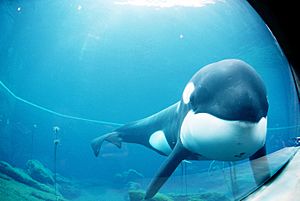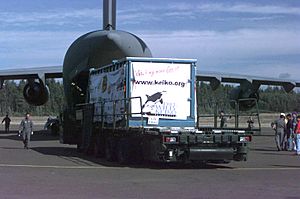Keiko (orca) facts for kids

Keiko at the Oregon Coast Aquarium
|
|
| Species | Orca (Orcinus orca) |
|---|---|
| Breed | Icelandic |
| Sex | Male |
| Born | c. 24 September 1976 Near Iceland |
| Died | 12 December 2003 (aged c. 27) Arasvikfjord, Norway |
| Notable role | Willy in Free Willy |
| Weight | 11,500 lb (5,200 kg) |
Keiko (also known as Siggi and Kago) was a famous male orca. He was born around September 24, 1976, near Iceland. Keiko became well-known for playing Willy in the 1993 movie Free Willy.
After the movie, many people wanted to help Keiko. In 1996, a big effort began to return him to the wild. He was flown back to Iceland in 1998. By 2002, Keiko became the first captive orca to be fully released into the ocean. Sadly, he passed away on December 12, 2003, from pneumonia in a bay in Norway. He was about 27 years old.
Contents
Keiko's Early Life
Keiko was caught near Reyðarfjörður, Iceland, in 1979 when he was about two years old. He was then sold to the Icelandic Aquarium. At that time, his name was Siggi. Later, he was called Kago.
In 1982, Keiko was sold to Marineland of Canada in Ontario, Canada. Here, he started performing for audiences. He also began to develop skin problems, which showed he wasn't very healthy. Older orcas at the park sometimes picked on him.
Keiko was sold again in 1985 to Reino Aventura, an amusement park in Mexico City, Mexico. At this park, he was given the name "Keiko." This is a Japanese name that means "lucky one." He was only about 10 feet long then. He lived in a tank that was really meant for smaller bottlenose dolphins.
Starring in Free Willy
Keiko became a movie star in 1993 when he played Willy in the film Free Willy. Because of the movie's popularity, people wanted to find a better home for him. By this time, Keiko was 21 feet long. His pool was only 22 feet deep, 65 feet wide, and 114 feet long. He lived with bottlenose dolphins but no other orcas.
Keiko was also underweight for his size. The water in his tank was often too warm. This made his skin problems worse. He had skin outbreaks from a virus, which made it hard to move him or release him into the wild.
Helping Keiko: The Foundation
After Free Willy came out, the movie's credits showed a phone number to help whales. Hundreds of thousands of people called in. This led to a huge public demand for Keiko to be set free.
Warner Bros. and the International Marine Mammal Project teamed up to help. In February 1995, they created the Free Willy-Keiko Foundation. With money from the foundation and donations from many schoolchildren, the Oregon Coast Aquarium in Newport, Oregon received over $7 million. This money was used to build new facilities to help Keiko get healthy. The goal was to eventually return him to the wild.
Reino Aventura gave Keiko to the Foundation. Before he left Mexico City, Keiko performed for the public one last time. Thousands of children came to say goodbye. Many more watched his journey overnight to the Mexico City International Airport. At this time, he weighed about 7,700 pounds (3,493 kg). A C-130 cargo plane, given by United Parcel Service (UPS), flew Keiko to Newport, Oregon, on January 8, 1996.
When Keiko arrived in Oregon, he moved into a new concrete pool. This pool held 2 million gallons of seawater. By June 1997, his weight had greatly increased to 9,620 pounds (4,364 kg).
Returning to the Wild
The idea of returning Keiko to the wild caused a lot of discussion. Some people believed that after so many years in captivity, he could not survive on his own. Scientists later said that while the release attempts were not fully successful, tracking him helped ensure his well-being.
Other people thought releasing him was a bad idea. A Norwegian politician even suggested Keiko should be killed for meat.
Despite the debates, the plan to prepare Keiko for the wild began. On September 9, 1998, he was flown to Klettsvík, a bay on the island of Heimaey in Vestmannaeyjar, Iceland. UPS helped again with ground transport. Keiko was moved in a special 30-foot container filled with cool saltwater. He was then flown by a C-17 Globemaster airplane from the United States Air Force. When the plane landed in Iceland, it had a problem with its landing gear, but Keiko was not hurt.
The Free Willy-Keiko Foundation and the Ocean Futures Society took care of Keiko daily. He first lived in a pen in Klettsvík Bay. Here, he was trained to get ready for his release. This training included supervised swims in the open ocean.
Ocean Futures left the project in late 2001. The Free Willy-Keiko Foundation and The Humane Society of the United States then managed the project until Keiko's death in 2003. Keiko was fully free by the summer of 2002. He left Icelandic waters in early August, following some wild orcas. However, he did not join their group.
His journey was tracked using a tag on his fin. About a month later, he arrived in Norway's Skålvik Fjord. He seemed to be looking for people and even let children ride on his back. His caretakers moved to Norway and continued to follow him by boat for the next 15 months. Tests showed that Keiko had eaten during his 900-mile (1,500 km) journey from Iceland to Norway. Keiko sometimes went near groups of wild orcas. But he stayed far away, about 100–300 meters (109 to 328 yards), always watching the closest orca.
Keiko's Death
Keiko died in Taknes Bay, Skålvikfjord, Norway, on December 12, 2003. He was swimming in the fjords at the time. He was 27 years old. The likely cause of his death was pneumonia.
Was the Release a Success?
Most experts agree that the project to free Keiko was not a complete success. This is because the orca struggled to live on his own in the wild. In Norway, Keiko had little contact with other orcas and was not hunting for food. For months before he died, people had to feed him every day.
One scientific study said that Keiko was seen diving with wild orcas only once. After that brief contact, he swam away and looked for human company. The study also confirmed that he was never truly part of a wild group. He "never integrated into a wild pod" and "could not break his need for human contact." His return to humans for food and friendship showed that the project had not fully succeeded in making him wild.
Reasons for Keiko's difficulty in adapting include being captured at a young age. Also, he spent a long time in captivity and had little contact with other orcas. He had also formed strong bonds with humans.
However, David Phillips, who led the Free Willy-Keiko Foundation, praised the project. He said, "We took the hardest candidate and took him from near death in Mexico to swimming with wild whales in Norway." He added that Keiko had "five years with the sights and sounds of natural seawater." Phillips believed it was a great success for Keiko's well-being. Others also called the release a "phenomenal success," giving him years of health and freedom.
The total cost to free Keiko was about US$20 million.
Some experts suggest that for orcas who have been in captivity for a long time, a "sanctuary" or "oceanic enclosure" might be a better option than full release. This is a large sea pen where they can live in natural seawater but still receive care. This could greatly improve their quality of life.
Keiko's Films
Keiko appeared in several films and TV shows:
- Quinceañera (1987; TV series)
- Keiko en peligro (1990)
- Free Willy (1993)
- Azul (1996; TV series)
- Keiko: The Untold Story (2010)
- The Whale Who Would Not Be Freed (2013)
See also
 In Spanish: Keiko (orca) para niños
In Spanish: Keiko (orca) para niños
- List of individual cetaceans


